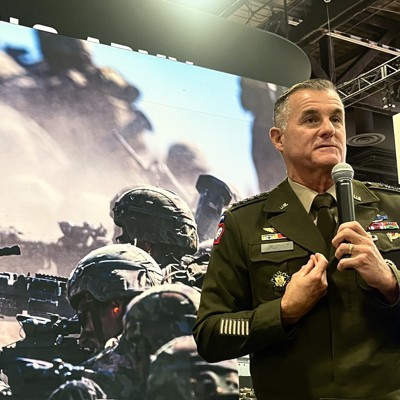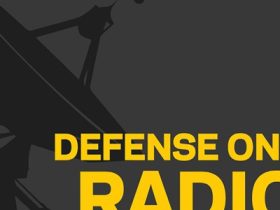The top U.S. Army commander in the Pacific region is sounding alarms about China’s “dangerous trajectory” and the rising threat of a war in Asia.
Gen. Charles Flynn, the outgoing commander of U.S. Army Pacific, said increased coordination and technology exchange between autocratic states such as China, Russia, Iran, and North Korea is a “very dangerous combination that we all should pay very, very close attention to”—in no small part because that coordination is putting greater pressure on the United States everywhere the military is conducting operations.
“There’s a limited regional war going on in Europe. There’s a limited regional war going on in the Middle East. We can ill afford another limited regional war in Asia. Why? Because it will be a global problem for all of us,” Flynn said at the AUSA conference, one of several D.C.-area venues he addressed this week.
In a farewell tour of sorts before he leaves his command in November, Flynn hit the capital city to address the AUSA conference, speak to reporters, and also appear at the Center for a New American Security to address policy wonks. For many outside of Washington, the name Flynn conjures recollections of his brother Mike, Donald Trump’s disgraced national security advisor and conspiracy pusher. (It’s an open secret that the brothers are not on good terms.) But the military and national security community knows Charles Flynn as a transformative figure in the U.S. Army and consummate champion for the importance of the U.S. Army in the Pacific in a fight against China.
“I would argue that this century is going to be defined by the relationship between the United States and China in Asia,” he said this week.
Flynn also argued that the Army would be critical in a fight with China. It’s not the obvious position in a region known less for its land masses than its oceans and vast distances. But he said the Army has undergone a profound transformation to make it not only relevant but essential.
“I often remind people that you’re not going to invade Taiwan with the Navy and Air Force. You need to generate an invasion force to invade Taiwan. Well, that invasion force exists in the [Chinese] eastern theater command and it is three army groups, and it’s north of 55,000 Chinese soldiers in those combat brigades,” he said.
But China, beginning with its 2015 reorganization and modernization push, has become a much more capable military. It’s a transformation that Flynn says in many ways mirrors how the United States military develops forces, with a large emphasis on the development of training centers, “taking pages right out of our book and putting them in place to build a force.”
Additionally, China has developed a massive rocket force and anti-access area denial capabilities. “It is historical in the scale of what they have…They have three things that we lack. They’re operating on interior lines that are right there. They have mass, and then they have magazine depth. These three things are what we have to counter,” he said.
Those elements of Chinese military power, rocket forces and anti-access/area denial capabilities—known as A2AD—create huge potential problems for the Navy and Air Force. Ships, which are observable from Chinese satellites, would be vulnerable to missile attack, while the Air Force relies heavily on visible runways that would also be open to attack in the event of a conflict. The U.S. Army can provide “an asymmetric counterweight that’s unmatchable,” Flynn says.
It’s a big part of the reason Flynn has worked to make the U.S. Army in the Pacific relevant in multiple domains, to develop a force that can protect air and maritime assets and work across air, sea, and space.
China has “the primary means of their attack approach, with their A2AD arsenal, against the strength of the United States, that strength is in the air and in the maritime domains,” as well as space and cyberspace, Flynn said. However, that Chinese arsenal was “not designed to find, fix, and finish land-based forces that are distributed, dispersed, mobile, reloadable network.”
Flynn lacks his brother’s appetite for political statements, but he’s not afraid to call out the military for what he sees as strategic errors. Perhaps unsurprisingly, he believes those errors stem from a systematic and decades-long underestimation of the importance of the U.S. Army to match China.
“I would argue that for many, many years, we’ve over invested in the aerial layer and over invested in the space layer. In the Indo-Pacific, we have to have a terrestrial collection layer, and that is a series of sensors that could both collect in all domains, to include open source, and share that with our partners,” he said.
Changing the game
To correct those perceived oversights, the U.S. Army has built new capabilities to attack China in new ways, even across long distances. One significant example: Multi-domain Task Force, or MDTF, teams.
“A few short years ago, this was merely a concept,” Flynn explained. “Now, it’s an organization that’s got four battalions, got a sustainment battalion, it’s got an integrated air-and-missile-defense battalion. It’s got a long-range precision-fires battalion, and then it’s got a multi-domain effects battalion and a task force headquarters.”
Those MDTF teams play a critical role in helping the Air Force and Navy be more effective in the Pacific, he said, by gathering information and intelligence the Chinese can’t easily counter, and providing options for hitting China from locations that aren’t so easy for enemy forces to find and hit.
“To me, that is game changing when it comes to being able to do missile defense and then being able to do counter-strike with long-range fires,” he said. “We have a theater information directorate. We have a theater strike effects group. This is space. This is information. This is lethal and non-lethal targeting all brought together at the operational level, at the theater army, so that the multi-domain task forces can take the long-range precision fires, from hypersonics to mid-range capability to (precision strike missiles), integrated air and missile defense… etc, to include future vertical lift sustainment capabilities, distributed forces, network forces, meshed forces, cellular forces—all in support of the joint force.”
The Army has worked hard to develop air and drone defenses, and is planning a composite air defense battalion to be based of Guam starting in 2027. But the service is putting new air defense capabilities into place now at multiple levels to counter the threat of China’s enormous stockpile of rockets, missiles, and drones.
“I think the advance of these advanced composite air defense battalions, where we bring together the integrated fire protection platform, the LTM sensor, IBCS RIG-360 and ALPS towers…that with what we’re doing with THAAD and Patriot and the [integrated air and missile defense] and, the software integration of those… This ability to be able to have what was originally designed to be a defensive capability, to sense and do an intercept and then to cross cue an offensive platform, to do counter strike,” is a huge improvement over a traditional, simple air defense capability.
The other key new advantage the Army now offers is the many allies and partners across the region that it has built close relationships with through joint exercises. By contrast, China is “doing it in a way that is, in many ways, is helping us, because it’s turning the allies and partners away from them,” he said.
INDOPACOM officials routinely point out the importance of more partners in the region—including governments and militaries that have difficult histories with each other—now not only participating in exercises together but actually asking to do so. Aside from seeing China as a threat, the other common feature among those militaries is actually the outsized role of their various armies. “The region is defined by armies… In the Philippines’ army, they have 12 divisions. They have more divisions than we have in the U.S.,” Flynn said.
The Taiwan question
If there is one area where Flynn is a bit more reticent, it’s the potential of a Chinese invasion of Taiwan. Military officials in in 2021 said that invasion could occur by 2027, making that assessment based in no small part on the words of Chinese President Xi Jinping and the rapid modernization of Chinese forces.
“I take him for his word, because if I did otherwise, and I think if any military leader did otherwise, that would be irresponsible,” Flynn said.
But when Defense One asked him specifically if he believed that moving U.S. forces, such as an MDTF team or Marine Littoral Regiment, to Taiwan might deter such an attack, he answered simply: “That is absolutely a policy question. I’m not going to render my opinion on it…We have a long standing relationship with Taiwan.”
Read the full article here








Leave a Reply